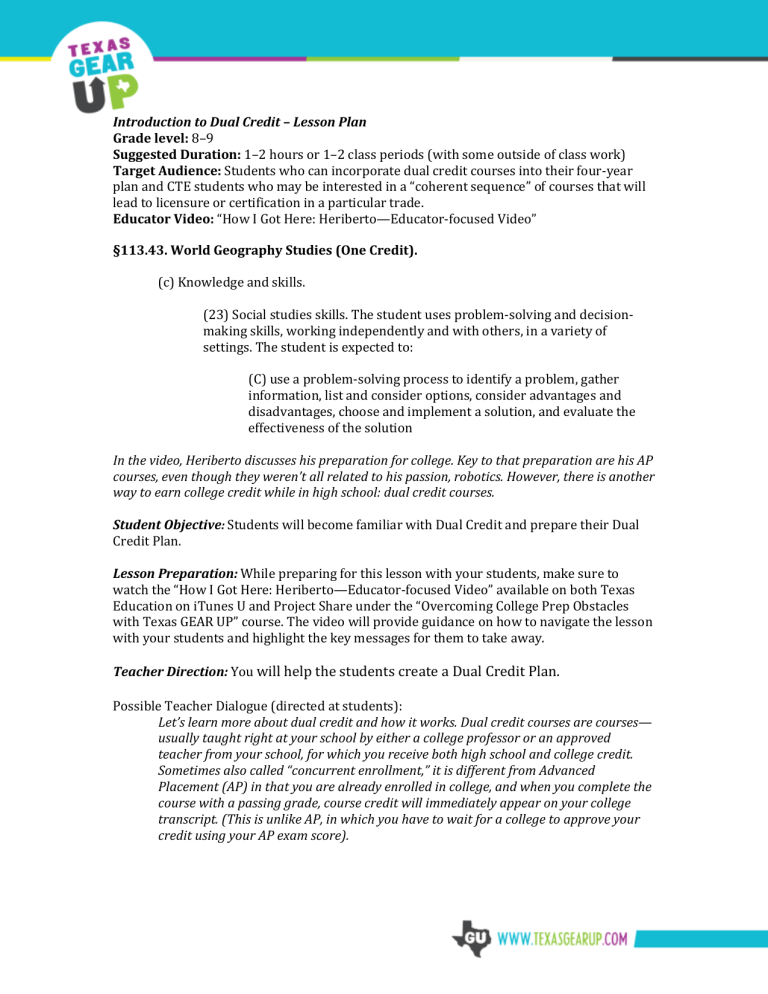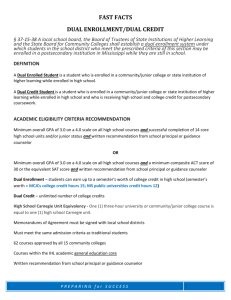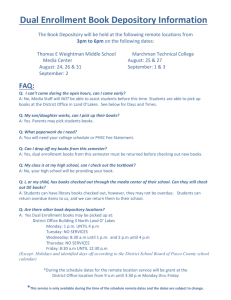Introduction to Dual Credit – Lesson Plan

Introduction to Dual Credit – Lesson Plan
Grade level: 8–9
Suggested Duration: 1–2 hours or 1–2 class periods (with some outside of class work)
Target Audience: Students who can incorporate dual credit courses into their four-year plan and CTE students who may be interested in a “coherent sequence” of courses that will lead to licensure or certification in a particular trade.
Educator Video: “How I Got Here: Heriberto—Educator-focused Video”
§113.43. World Geography Studies (One Credit).
(c) Knowledge and skills.
(23) Social studies skills. The student uses problem-solving and decisionmaking skills, working independently and with others, in a variety of settings. The student is expected to:
(C) use a problem-solving process to identify a problem, gather information, list and consider options, consider advantages and disadvantages, choose and implement a solution, and evaluate the effectiveness of the solution
In the video, Heriberto discusses his preparation for college. Key to that preparation are his AP courses, even though they weren’t all related to his passion, robotics. However, there is another way to earn college credit while in high school: dual credit courses.
Student Objective : Students will become familiar with Dual Credit and prepare their Dual
Credit Plan.
Lesson Preparation: While preparing for this lesson with your students, make sure to watch the “How I Got Here: Heriberto—Educator-focused Video” available on both Texas
Education on iTunes U and Project Share under the “Overcoming College Prep Obstacles with Texas GEAR UP” course. The video will provide guidance on how to navigate the lesson with your students and highlight the key messages for them to take away.
Teacher Direction: You
will help the students create a Dual Credit Plan.
Possible Teacher Dialogue (directed at students):
Let’s learn more about dual credit and how it works. Dual credit courses are courses— usually taught right at your school by either a college professor or an approved teacher from your school, for which you receive both high school and college credit.
Sometimes also called “concurrent enrollment,” it is different from Advanced
Placement (AP) in that you are already enrolled in college, and when you complete the course with a passing grade, course credit will immediately appear on your college transcript. (This is unlike AP, in which you have to wait for a college to approve your credit using your AP exam score).
Have students complete the Getting Started Checklist Worksheet, which includes the following:
1.
Look at the course catalog for your school. See what dual credit courses are offered and at what grade levels they are recommended. Bear in mind that if the course you want is not offered at your school, you might still be able to take the course as a special student at the college. Contact the college near you and ask how to enroll as a “special student.”
2.
See if the dual credit courses have prerequisites at your school.
3.
Find out which teachers at your school teach which dual credit courses. Email or stop by during office hours and ask to see the course syllabus.
4.
Find out what the estimated homework requirements are.
5.
Find out from the teacher or your counselor whether there is any cost to you for tuition, fees, or books. Some colleges waive tuition for dual credit students.
Have students complete the Making Your Dual Credit Plan Worksheet, which includes the following:
Dual credit courses you would like to take and when
Homework load per week
Plan to pay for materials and/or fees
Number of credits/licenses/certifications you plan to graduate with
Entry requirements for dual credit courses
Resources available to help you with your dual credit schoolwork
Likelihood that you will take these courses
What you can do now to prepare for these courses
Students may work with a teacher or counselor in or out of class time to complete the plan.
After plans are complete, ask students to do a “Think, Pair, Share” in class to share their reflections on the Dual Credit Plan.
Possible Teacher Dialogue (directed to students):
We are going to do a “think, pair, share” to discuss our Dual Credit Plans. First, please think about and review your Dual Credit Plan. Then get into pairs. Pick one course from your plan and talk about it with a partner. Include the name of the course, the homework load, your plan to pay the fees, and the number of credits you plan to graduate with. Also talk about entry requirements for the course, resources in the school that can help you if you need help with the course, the likelihood that you will take this course, and what you can do now to prepare for the course. Your partner does the same to you. Then you will orally share a summary of your partner’s plan to the class and give one piece of advice to your partner. Your partner will do the same for you.
2








